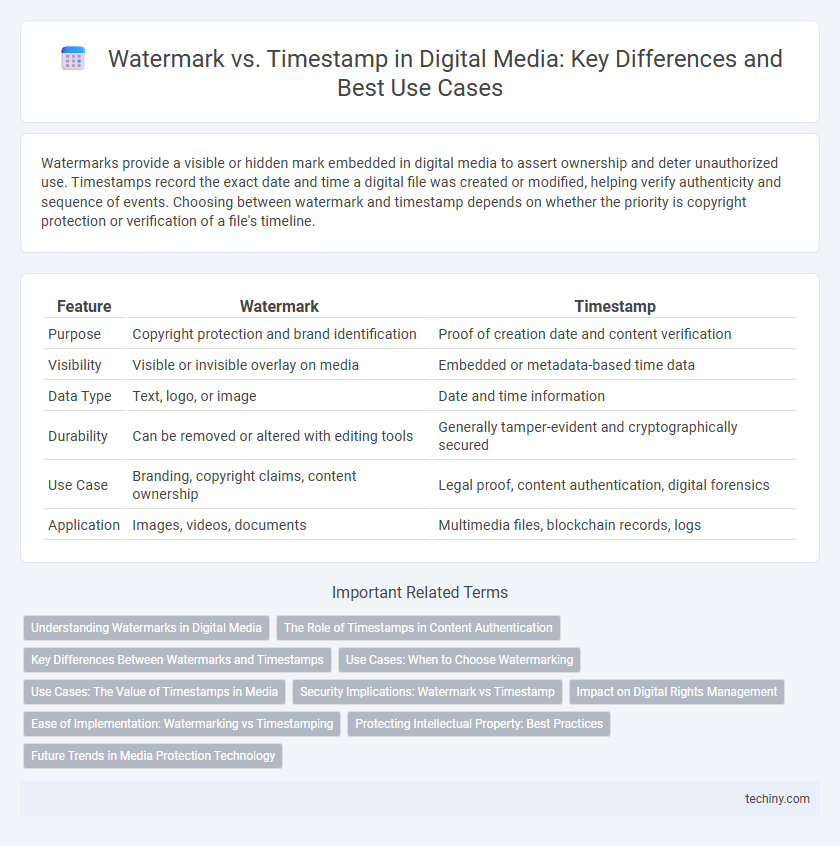Watermarks provide a visible or hidden mark embedded in digital media to assert ownership and deter unauthorized use. Timestamps record the exact date and time a digital file was created or modified, helping verify authenticity and sequence of events. Choosing between watermark and timestamp depends on whether the priority is copyright protection or verification of a file's timeline.
Table of Comparison
| Feature | Watermark | Timestamp |
|---|---|---|
| Purpose | Copyright protection and brand identification | Proof of creation date and content verification |
| Visibility | Visible or invisible overlay on media | Embedded or metadata-based time data |
| Data Type | Text, logo, or image | Date and time information |
| Durability | Can be removed or altered with editing tools | Generally tamper-evident and cryptographically secured |
| Use Case | Branding, copyright claims, content ownership | Legal proof, content authentication, digital forensics |
| Application | Images, videos, documents | Multimedia files, blockchain records, logs |
Understanding Watermarks in Digital Media
Watermarks in digital media serve as embedded markers that authenticate ownership and deter unauthorized use by embedding visible or invisible logos, text, or patterns within images and videos. Unlike timestamps, which record the creation or modification date, watermarks enhance copyright protection and brand recognition by maintaining consistent visibility regardless of file alterations. Advanced watermarking techniques utilize robust algorithms to ensure resilience against compression, cropping, and other editing processes while preserving media quality.
The Role of Timestamps in Content Authentication
Timestamps play a crucial role in content authentication by providing verifiable proof of when digital media was created or modified, ensuring the integrity and originality of the content. Unlike watermarks that embed visible or invisible marks within media, timestamps serve as immutable records linked to a trusted third party or blockchain, enhancing trustworthiness in digital transactions. This temporal validation helps prevent fraud and unauthorized alterations, making timestamps indispensable in legal and copyright disputes involving digital media.
Key Differences Between Watermarks and Timestamps
Watermarks embed visible or invisible marks within digital media to assert ownership and prevent unauthorized use, whereas timestamps record the exact date and time of content creation or modification to verify authenticity and chronology. Watermarks primarily serve as a deterrent against piracy by maintaining brand identity, while timestamps provide legal evidence and track content history for digital rights management. The key difference lies in watermarks altering the media's appearance or metadata for protection, whereas timestamps focus on time-based validation without changing visual elements.
Use Cases: When to Choose Watermarking
Watermarking is ideal for protecting intellectual property and deterring unauthorized use of digital media by embedding visible or invisible marks that assert ownership and authenticity. It is commonly used in image and video distribution, where permanent branding or copyright information needs to be preserved across sharing platforms. Watermarking is preferred over timestamps when the primary goal is to maintain content integrity and brand recognition rather than merely recording the creation or modification time.
Use Cases: The Value of Timestamps in Media
Timestamps in digital media provide precise chronological context, enabling accurate tracking of content creation, modification, and distribution times. They are essential for verifying the authenticity of live broadcasts, legal evidence in copyright disputes, and synchronizing multimedia elements across platforms. Unlike watermarks, which primarily serve brand protection and ownership claims, timestamps offer critical temporal metadata that enhances content integrity and auditability.
Security Implications: Watermark vs Timestamp
Watermarks provide robust security by embedding invisible or visible marks within digital media, deterring unauthorized copying and helping to trace sources of leaks. Timestamps enhance security by certifying the exact creation or modification time, enabling verification of authenticity and preventing backdating fraud. While watermarks focus on content protection and source identification, timestamps emphasize temporal integrity and legal validation of digital media.
Impact on Digital Rights Management
Watermarks embed identifiable information directly into digital content, providing robust protection against unauthorized use by enabling traceability and forensic analysis in Digital Rights Management (DRM). Timestamps serve as proof of content creation or modification time, supporting DRM by verifying content authenticity and ensuring proper usage rights within specified timeframes. Both techniques play crucial roles in maintaining content integrity and enforcing copyright policies in digital media ecosystems.
Ease of Implementation: Watermarking vs Timestamping
Watermarking requires embedding visible or invisible marks into digital media, often demanding specialized software and processing time, which can complicate implementation. Timestamping involves recording the creation or modification time using blockchain or digital certificates, typically offering a straightforward and automated process. For projects emphasizing ease of implementation, timestamping generally presents a more efficient and accessible solution compared to watermarking.
Protecting Intellectual Property: Best Practices
Watermarks embed visible or invisible logos in digital media to assert ownership and deter unauthorized use, while timestamps provide verifiable proof of creation time to establish content authenticity. Combining watermarks with blockchain-based timestamps offers a robust approach to protecting intellectual property by linking visible ownership marks with immutable creation records. Best practices involve using high-quality, non-intrusive watermarks paired with reliable timestamping services to enforce rights and support legal claims effectively.
Future Trends in Media Protection Technology
Future trends in media protection technology emphasize advanced watermarking methods leveraging AI for real-time content authentication and tamper detection. Timestamp technologies are evolving with blockchain integration to provide immutable, verifiable proof of content creation and modification times. Combining AI-driven watermarking with decentralized timestamping offers a robust framework against piracy and unauthorized distribution in digital media.
Watermark vs Timestamp Infographic

 techiny.com
techiny.com